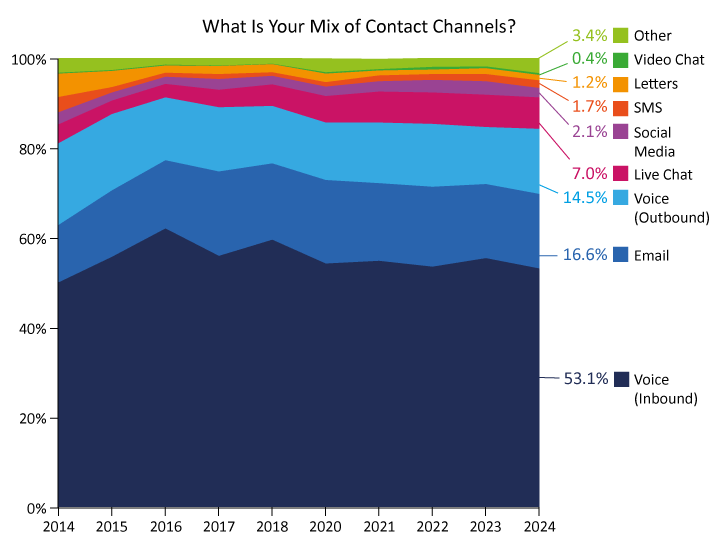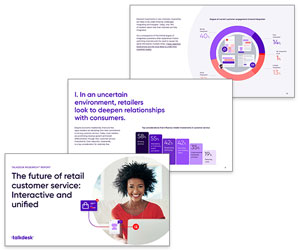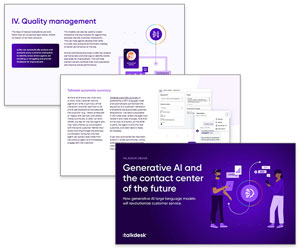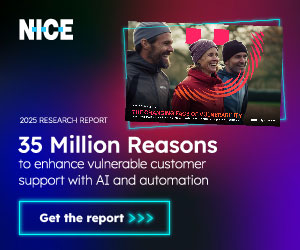Ever wondered how the humble call centre gave rise to the complex contact centres we see today?
Paul Weald explains all! From how the advent of the internet and smartphones redefined the channels contact centres offer their customers, to how AI is shaping the future.
Where Did It All Begin?

I’ve been in the industry long enough to remember the dawn of call centres, where consumers first started to pick up the phone to contact businesses when they wanted to do banking transactions, arrange insurance, and make catalogue purchases.
In those days, the only channel was phone, but the advent of the internet changed that as businesses went online and email became a channel for desktop-based communications.
Then as smartphones took off, contact centres adapted to support a greater range of chat and messaging channels.
Demand for Legacy Channels Hasn’t Gone Away
From a technology vendor perspective, the omnichannel contact centre – increasingly driven by conversational AI – is now the new normal. But what’s interesting is that demand for what you might regard as legacy channels hasn’t gone away.
The most recent survey by Call Centre Helper has 67% voice and 16% email, still significantly higher than the digital support channels of chat and messaging.
And despite the COVID years when everyone was working from home and Zoom and MS Teams took off, when it comes to consumer communications with businesses, video chat barely registers – at less than 1%.

A Proven Difference in the Metrics for Chat-Assisted Support vs. Unassisted Self-Serve
Some 10 years ago, I worked for a global airline where we had a clear business view of the role of live chat as part of a digital customer support strategy.
The website had a key role to play in consumer flight bookings and pre-flight service (e.g. online check-in).
We targeted key stages of the sales and service digital customer journeys and proactively offered chat based on the length of time a user was spending on these specific pages.
What could be proven was the relative difference in these metrics for chat-‘assisted’ support versus unassisted ‘self-serve’.
The simple but effective technology hack was that each chat session placed a cookie on the customer’s device.
That meant that the use of chat could be assessed from both a digital sales conversion and order value perspective, as well as a digital service task completion rate.
What could be proven was the relative difference in these metrics for chat-‘assisted’ support versus unassisted ‘self-serve’.
What we saw was that live chat increased digital sales booking rates, revenue and customer experience compared to unassisted self-serve.
What convinced us of the effectiveness of this approach was that, at the end of each chat session, the user was offered a survey.
Completion rates were in the 30%+ range – way higher than any other channel – because we could catch people whilst they were still online, and the proportion of 5-star reviews was off the scale. We knew it worked!
For information on how to write great customer support scripts for live chat, read our article: How to Write Good Customer Support Chat Scripts – With Examples
Time-Pressed Users Get Frustrated When Self-Serve Channels Don’t Work Intuitively
Fast-forward to today, and the drive from technology vendors to replace human agents with automated chatbots, then I wonder if the north star reason why chat was so effective – at helping customer complete ‘important’ online tasks – has been lost?
What’s also a factor now is that as service channels proliferate, customer behaviour has changed, introducing a new set of challenges.
Time-pressed users get more easily frustrated when self-serve channels don’t work intuitively and effectively first time, and as a result, they chat and then call, thwarting efforts to reduce or deflect contact volume.
If you want to know how the experts think self-service will evolve, read our article: 10 Changes Set to Redefine the Future of Self-Service
There’s Now a New Type of Failure Demand
As consumer attitudes (to self-serve) are changing, so a new type of failure demand is emerging.
This is illustrated in the CCMA 2024 Voice of the Contact Centre Consumer report, where 70% of consumers report that they have contacted customer service when trying to resolve a self-serve query themselves.
So, it’s becoming inevitable that offering the opportunity to switch to live assistance is now widely accepted as a prerequisite for self-serve journeys.
In that same report, 39% of consumers report a perception that chatbots are getting better – reflecting the improvements that contact centre operations are making – but there’s still a long way to go until that’s the majority view.
Therefore, it’s clear that the use of technology is evolving, where the leading exponents are orchestrating more efficient and effective connections.
Just Because Tools Are Available, It Doesn’t Mean They Are Widely Adopted
The latest tools are enabling service organizations to connect journeys and information across channels in ways that improve both customer experiences and agent productivity. But just because the tools are available, doesn’t mean that they are widely adopted.
Recently I worked on a technology transformation project for a large insurer, and their problem statement was that they needed to replace legacy platforms that were at end of life.
During the procurement process, the tech vendors quite rightly talked a lot in their pitches about channel orchestration.
That made the business case compelling to adopt new working practices when it came to channel management, in terms of driving up self-serve adoption rates and reducing failure demand.
If you are looking for advice on creating a business case for your contact centre, read our article: What to Include in a Business Case for New Technology
Operations Need to Take Full Advantage of CCaaS to Tackle Channel Management
But, and here’s the rub, it was tied to the operational ability to implement change. Until operations take full advantage of the CCaaS tech capabilities that they buy, they won’t be able to tackle the underlying problems of channel management.
And for initial phases of the project implementation, the client was understandably focused on a ‘lift and shift’ of current working practices, as this was less risky for them to implement.
So what needs to change? Central to operational success is to have a defined strategy to drive customer adoption of self-service channels.
Focus chatbots on low-complexity user needs and then help customers efficiently connect with agents in the most effective channel for those customer journey moments that matter most. Measure adoption rates and then adapt and learn from user behaviour.
And beware the hype, as too often it fails to materialize! The analysts first started singing the praises of AI back in 2016. At that time, I remember sitting in the audience of an industry event where Gartner made this projection:
“By 2020, AI will disrupt the jobs of 1,000,000 phoned-based customer support agents.”
The reality, however, was take-up over that period was on a much lower trajectory. By the early 2020s, benchmark surveys showed that 61% of interactions were (still) agent-assisted vs. 39% self-service.
Want to know what’s happening in the CCaaS world right now and what the future might hold? Read our article: Evolution of CCaaS – What’s Next?
Early Adopter Businesses Using Gen AI Today Report Better Performance Outcomes
For call to truly evolve to chat, the key is that self-serve works well enough for customers to trust themselves to use it and the automated support mechanisms when assistance is required.
Deloitte Digital research (May 2024) sums this up nicely by showing that those early adopter businesses using Gen AI today report better performance outcomes than those yet to adopt these tech advances – with a 15 to 20 percentage point improvement in lower customer effort, higher agent productivity, improved deflection, and reduced agent stress that these tools can provide.
So, the onus is on operations to adopt these technologies and fine-tune performance levels so that customers can take full advantage.
Written by: Paul Weald, The Contact Centre Innovator
If you are looking for more great articles on customer support channels, read these next:
- Move Over Omnichannel… What’s Coming Next?
- Why Is Omnichannel Customer Service Important?
- 22 Ideas to Help Design a Great Digital Experience
Author: Paul Weald
Reviewed by: Megan Jones
Published On: 2nd Oct 2024 - Last modified: 9th Oct 2024
Read more about - Technology, Customer Service, Editor's Picks, Omnichannel, Paul Weald, Top Story, Top Technology Stories








































